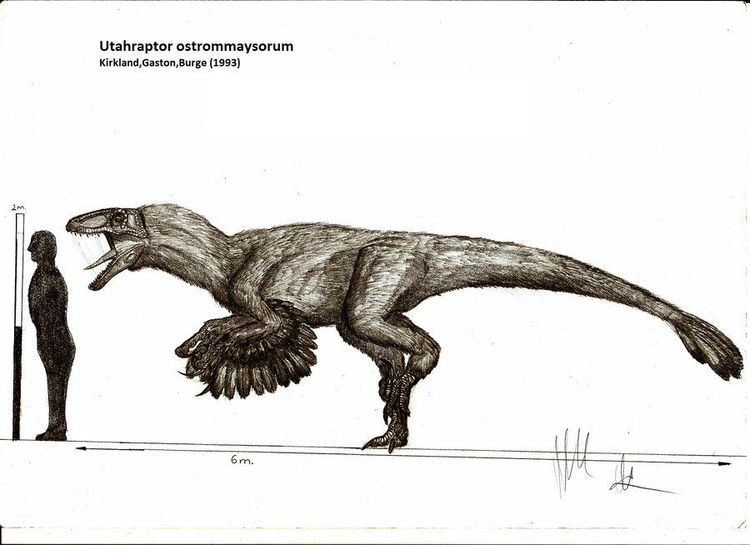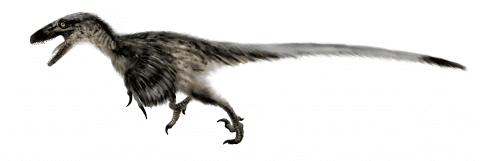Kingdom Animalia Suborder Theropoda Subfamily †Dromaeosaurinae Higher classification Dromaeosaurinae Rank Genus | Clade Dinosauria Family †Dromaeosauridae Scientific name Utahraptor Phylum Chordata Order Saurischia | |
 | ||
Similar Dinosaur, Velociraptor, Deinonychus, Dromaeosauridae, Allosaurus | ||
Utahraptor unlocked the isle
Utahraptor (meaning "Utah's predator") is a genus of theropod dinosaurs. It contains a single species, Utahraptor ostrommaysorum, which is the largest known member of the family Dromaeosauridae. Fossil specimens date to the upper Barremian stage of the early Cretaceous period (in rock strata dated to 126 ± 2.5 million years ago).
Contents

DescriptionEdit

The holotype specimen of Utahraptor is fragmentary, consisting of skull fragments, a tibia, claws and some caudal (tail) vertebrae. These few elements suggest an animal about twice the length of Deinonychus. Like other dromaeosaurids, Utahraptor had large curved claws on their second toes. One claw specimen is preserved at 22 centimetres (8.7 in) in length and is thought to reach 24 centimetres (9.4 in) restored.

The largest described U. ostrommaysorum specimens are estimated to have reached up to 7 m (23 ft) long and somewhat less than 500 kg (1,100 lb) in weight, comparable to a polar bear in size.

It is thought that Utahraptor may be closely related to the smaller Dromaeosaurus and the giant Mongolian dromaeosaurid genus Achillobator.

Although feathers have never been found in association with Utahraptor specimens, there is strong phylogenetic evidence suggesting that all dromaeosaurids possessed them. This evidence comes from phylogenetic bracketing, which allows paleontologists to infer traits that exist in a clade based on the existence of that trait in a more basal form. The genus Microraptor is one of the oldest known dromaeosaurids, and is phylogenetically more primitive than Utahraptor. Since Microraptor and other dromaeosaurids possessed feathers, it is reasonable to assume that this trait was present in all of Dromaeosauridae. Feathers were very unlikely to have evolved more than once, so assuming that any given dromaeosaurid, such as Utahraptor, lacked feathers would require positive evidence that they did not have them. So far, there is nothing to suggest that feathers were lost in larger, more derived species of dromaeosaurs.
In a 2001 study conducted by Bruce Rothschild and other paleontologists, two foot bones referred to Utahraptor were examined for signs of stress fracture, but none were found.
DiscoveryEdit
The first specimens of Utahraptor were found in 1975 by Jim Jensen in the Dalton Wells Quarry in east-central Utah, near the town of Moab, but did not receive much attention. After a find of a large foot-claw by Carl Limoni in October 1991 James Kirkland, Robert Gaston, and Donald Burge uncovered further remains of Utahraptor in 1991 in the Gaston Quarry in Grand County, Utah, within the Yellow Cat and Poison Strip members of the Cedar Mountain Formation. Radiometric dating has shown that these parts of the Cedar Mountain Formation were deposited about 124 million years ago. The type specimen, CEU 184v.86, is currently housed at the College of Eastern Utah Prehistoric Museum, although Brigham Young University, the depository of Jensen's finds, currently houses the largest collection of Utahraptor fossils.
The type species (and only known species of Utahraptor), Utahraptor ostrommaysorum, was named by Kirkland, Gaston, and Burge in June 1993 for the American paleontologist John Ostrom from Yale University's Peabody Museum of Natural History, and Chris Mays of Dinamation International. Originally, in the specific name, the singular genitive ostrommaysi was used but, in 2000, this was emended by George Olshevsky to the plural. Earlier, it had been intended to name the species "Utahraptor spielbergi", after film director Steven Spielberg, in exchange for funding palaeontological research, but no agreement could be reached on the amount of financial assistance.
In 2001, Kirkland et al. discovered a fossil block of sandstone in eastern Utah containing as many as six individuals, including an adult measuring about 4.8 m (16 ft), four juveniles and a baby about 1 m (3.3 ft). Also fossilized with the predators are the remains of iguanodonts. It is theorized by Kirkland that the Utahraptors attempted to attack helpless prey mired in quicksand, and were themselves mired in the attempt to attack the victim. Similar sites such as the Cleveland-Lloyd Quarry and La Brea Tar pits house similar predator traps. Examination of the fossil is ongoing after a decade of excavation, but if correct it may be one of the best preserved predator traps ever discovered. The fossil may further reveal aspects into the behavior of Utahraptor, such as whether it might have hunted in groups like Deinonychus is believed to have done. Based on evidence gathered from the site, the Utahraptor were drawn to a trap made of quicksand by either carrion or helplessly mired living prey. Whether all the Utahraptor individuals were mired simultaneously or were lured in one by one is unclear as work is currently halted on the specimens, but the answer may yet come to light once crowdfunding efforts to bring in professional excavator Scott Madsen are completed.
ClassificationEdit
Below is a cladogram by Senter et al. in 2012.
